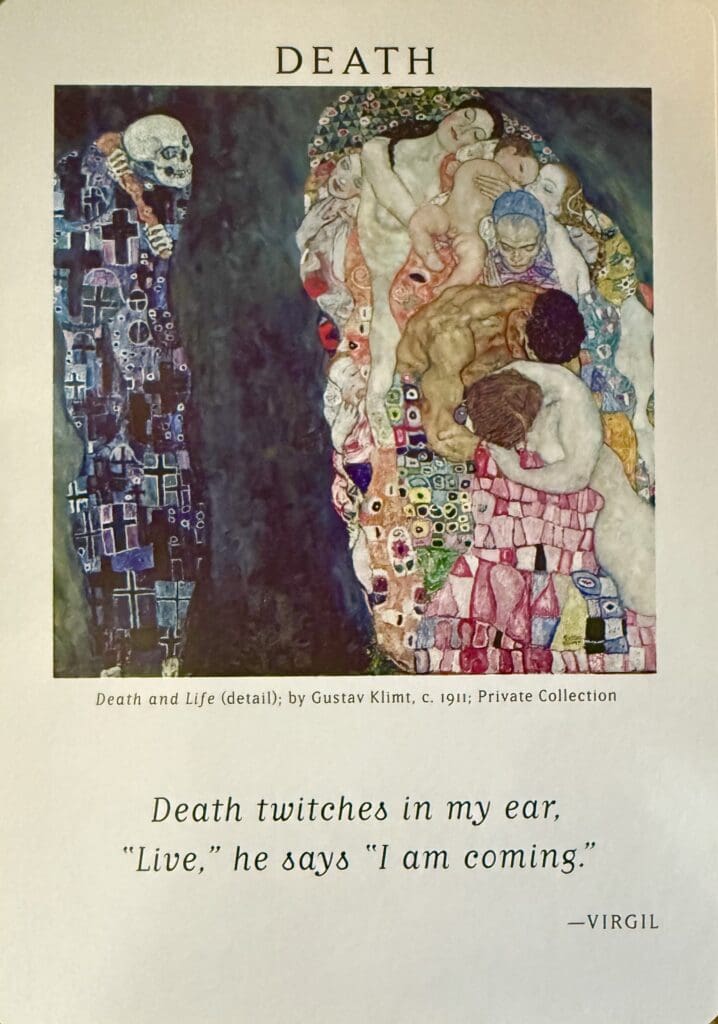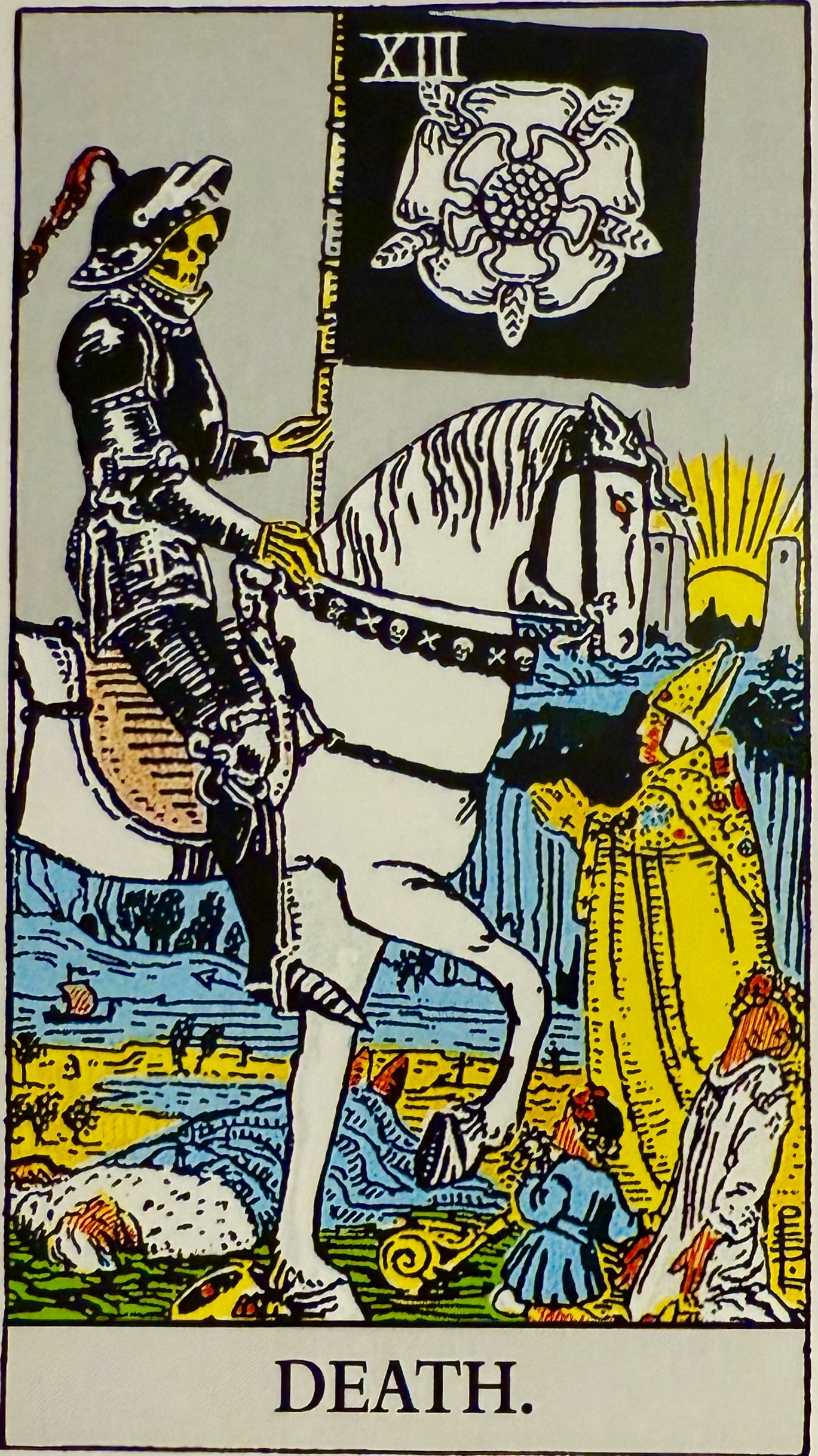The Death card—Key 13 in the Major Arcana—is one of the most misunderstood symbols in the Tarot. Its stark name and imagery can provoke fear or superstition. The number 13 has long carried an air of mystery and discomfort. Even today, many hotels skip the room number 13, and high-rise buildings often leave out numbering the 13th floor. But as with much in Tarot, what appears ominous on the surface often conceals a profound spiritual truth. In reality, the Death card is not about physical death. It is about release, renewal, and the sacred, inescapable process of transformation.
I understand that many people are frightened by the Death card in Tarot. I’ve had lovely conversations with people who are intrigued with what I do, yet their fear of the Death card keeps them from having a Tarot reading. If you know me you know I don’t spend time or energy toward convincing anyone to have a reading if they are not comfortable with it. I’ll answer questions and explain the card’s symbology and meanings if one asks, but I honor their wishes if a reading does not feel comfortable for them.
Because we have a Friday the 13th upcoming on the calendar, I thought I’d share with you some of my thoughts around death and immortality and, specifically, the symbolisms and meanings in Tarot’s Death card.
Tarot and the Language of Archetypes
It’s helpful to first understand that the Tarot is a symbolic mirror of the human experience. Each card, especially the Major Arcana, represents an archetype—a universal pattern or energy that lives within all of us. Archetypes are ancient and timeless; they show up across cultures, mythologies, and spiritual traditions. We see them in the Hero, the Mother, the Seeker, the Fool, the Sage… and yes, in Death.
These aren’t just characters in a story—they are living patterns that help us understand ourselves and our journey through life. When an archetype appears in a reading, it’s inviting you to recognize that part of yourself, and work with it consciously. Let’s now explore the images and meanings on the Death card, using the Waite-Smith Tarot image as our example.
The Symbolism and Spirit in the Death Card
A skeleton in armor rides a white horse that tramples over a fallen king and draws near to a child and a woman, who turn from him in dread, representing fear. The standing figure is a bishop in a miter/ headdress shaped like a fish and represents the zodiac sign of Pisces where two fish swim in both direction at the same time, like the yin-yang sign, representing the cycles of Life.
I notice the waterfall in the backdrop; water representing feelings and emotions. I ponder our Collective Conscious and see this representing unity, our Oneness with Source.
In the forefront note how the Bishop is holding out his hands to Death; I see this as a kind of blessing in disguise because as hard as it is to let something go, it can also be a relief that the situation has come to an end. While Death can be terrifying, it can also be an exhilarating initiation into the transformation of consciousness.
Notice the crown of the king has been knocked off his head. There is an aspect here of a fallen ego, the release of tight control and/or of false beliefs. Accepting and realizing the need for endings, Death assists us in leaving the past behind and reminds us to live for today and even to be humble.
The white horse Death rides represents pure solar energy, a symbol of Spirit manifested. The two pillars in the background with the sun rising between them represent immortality; the dawn after death, the transition from life to death and death to life. Like the Phoenix rising from the ashes Death is always followed by resurrection and rebirth.
Tarot’s Death card is represented by the zodiac sign of Scorpio, which is ruled by the planet Mars and depicted as a scorpion, a lizard, an eagle, or phoenix. The link between Scorpio and the phoenix represents having trans-formative powers, or the ability to transform oneself, one’s life, again and again.
Death carries a banner which shows a five-petaled rose, the symbol of Mars and of Life-force. The river in the background indicates the constant circulation of the Life-force into materialization and out again; demonstration of the power of affirmative prayer. The water, as it flows to the sea is sucked up by the sun to form clouds, from which rain falls into the streams and then to the river again. The never-ending force of the presence of God which brings me a profound sense of the words ‘The power and the glory of the Universe are with me.’
The fundamental meaning of Tarot’s Key 13 is the perpetual transformation of Life. It represents change, transformation, regeneration, birth, death of ego, and renewal of Spirit. I see Death as the twin sibling to Life, representing half of the Universal Transforming Principle that states everything is energy and energy is in a constant state of change and transformation. We are One with Spirit and Spirit is immortal. Therefore, as Spirit we descend into matter and so must return to Source, Spirit, ever continuing the cycles of the Life-force.
The Death Card in a Tarot Reading Showcases Endings and Beginnings in Our Lives.
Over the past few decades I’ve lived in areas that are known as ‘snowbird’ towns where I’ve worked with many retired, or soon to be retired, persons. It’s super interesting that this card, Death, often shows up in a reading when someone is making a transition into retirement. Ending of one cycle in their life (position, title, focus) and the opening of a new cycle forward.
As life is a grand cycle of beginnings and endings, let us embrace the spiritual meanings of the Death card as it reminds us that change is in our nature and change offers the blessing of transformation. May we transform with grace and understanding.



